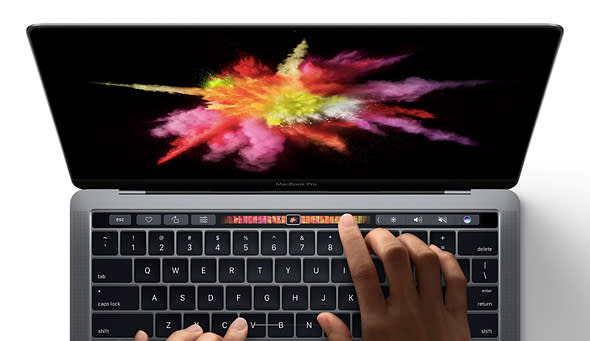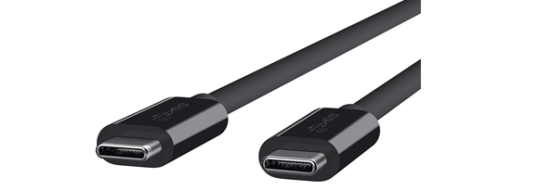Apple has killed every jack but one: Meet USB-C
Apple (AAPL) introduced a new laptop last week: the 2016 MacBook Pro.
Headline No. 1 is that instead of that function-key row above the keyboard, it has a thin, touch-sensitive screen, which displays useful buttons that change as you switch from program to program.

Headline No. 2 is more troublesome. Apart from a headphone jack, the laptop has no jacks you’d recognize. No USB jacks. No video-output jack (DVI, VGA, or HDMI). No SD card slot. Not even the magnetic MagSafe power jack that Apple itself invented!
The new laptop has only USB-C jacks. Two or four of them. (Apple calls them Thunderbolt-3, but for most people’s purposes, they’re USB Type C.)

In the short term, this means that you’ll need a lot of adapters. No existing flash drive, camera, monitor, inkjet printer, Apple power cord, or USB hard drive will connect without an adapter.
Incredibly, even the iPhone’s own Lightning cable won’t connect without an adapter! (Which costs $25.)

Apple says: Welcome to the future.
I say: Well, if USB-C is the future, then you may as well get to know it.
A crash course in USB-C
If Apple had to use only one jack on its new laptops, at least it picked a winner. USB-C is fantastic.

In the big picture, USB-C is technology that will save us time, money, and frustration. It’s a breakthrough that will even keep tons of e-waste out of the landfills.
This single, tiny connector can carry power, video, audio, and data—simultaneously. It can, in other words, replace a laptop’s power cord, USB jacks, video output jack, and headphone jack. (On the new MacBook Pros, for example, you can plug the power cord into any of the four USB-C jacks.)

And a USB-C cable is identical top and bottom, so you can’t insert it the wrong way. (Woohoo!)
It’s identical end for end, too, so it doesn’t matter which end you grab first.
It feels more secure than USB when you insert it; you get a physical click instead of just relying on friction to hold it.
USB-C can charge your gadget faster and transfer data faster than what’s come before, too.
It’s tiny—about the size as micro USB—so the same cable can charge your phone and tablet and laptop.
And the brand doesn’t matter. My Samsung USB-C cable can charge your MacBook Pro and his Surface tablet.
Can you imagine? You’re witnessing the dawn of the universal charging cord. We can all dump out our drawers full of ugly, mismatched, proprietary charging bricks, long since separated from their original devices, and recycle it all. Now we’ll need only one kind of cable for everything.
The specifications for USB-C were finalized late in 2014. That’s astonishing for two reasons: First, it was dreamed up by engineers and executives from every major electronics company, working side-by-side for three years—even blood rivals like Apple and Google (GOOG).
Second, you can already buy phones, tablets, and laptops that come with USB-C jacks—from Google, Microsoft (MSFT), Nokia, and others. (Apple’s strange, expensive, slow 12-inch MacBook was the first to have a USB-C jack. One.)
Already, you’ll find USB-C on all of Google’s phones, tablets, and laptops; Microsoft’s laptops; the Samsung Galaxy Note 7 (kaboom); the Motorola Z series; the OnePlus 2 phone; the Asus ZenPad 8; the Nokia N1; and so on.
The MacBook Pro does have a headphone jack—but USB-C is perfectly capable of conducting audio, too.
(For my exclusive interview with the leaders of the team that created USB Type C, click here.)
What it all means
So USB-C has fantastic promise. Eventually, the payoff will be gigantic, convenient, and universal.
But clearly, the world isn’t ready to go all USB-C yet. Change is annoying. We’re in for a couple of years of transition and fumbling with adapters that accommodate all our old USB gear: flash drives, hard drives, scanners, printers, cameras, and so on.
So why did Apple switch to USB-C so suddenly, and with such total commitment? Does it just want to make us livid?
The obvious answer is size and weight. Inside a laptop, there’s a block of metal that has to receive every kind of connector, and some of them prevented the MacBook from getting thinner. It’s the age-old Apple story: Toss the old, embrace the new, and drag the world along with it.
USB-C is a fantastic, genius, intelligently designed universal jack. For the sake of Apple fans, let’s just hope the world makes the switch as soon as possible.
David Pogue, tech columnist for Yahoo Finance, welcomes non-toxic comments in the Comments below. On the Web, he’s davidpogue.com. On Twitter, he’s @pogue. On email, he’s [email protected]. Here’s how to get his columns by email.
